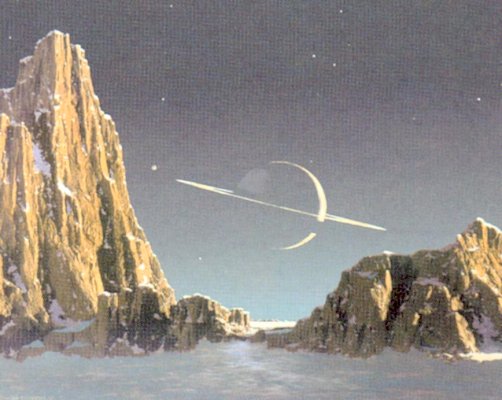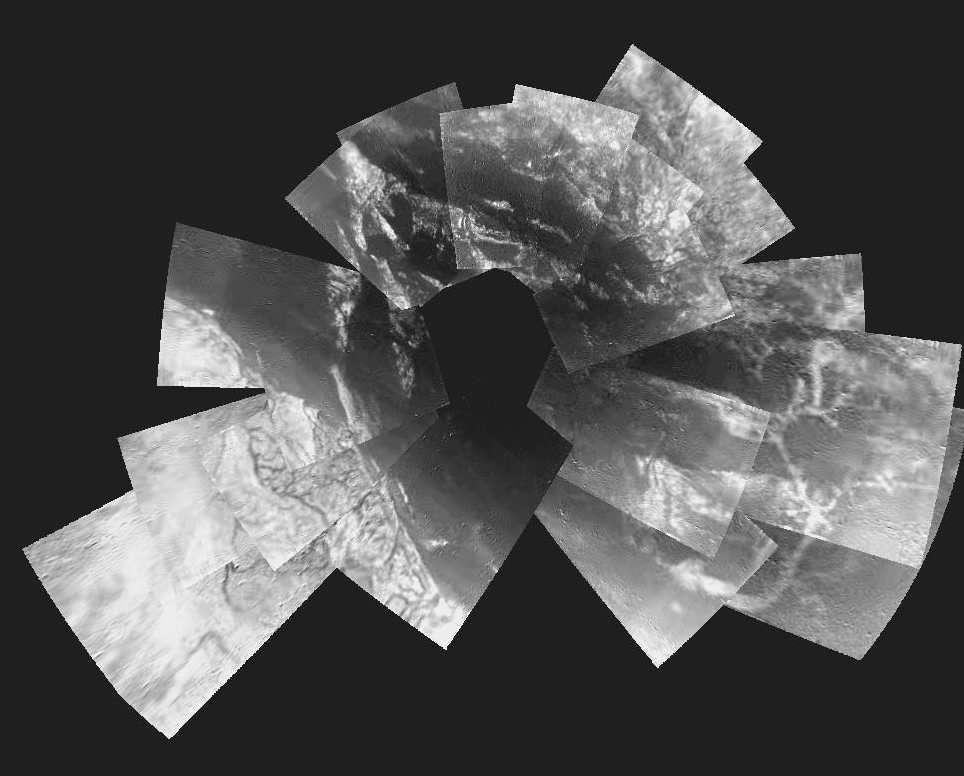 Voyager 1 is our farthest missile. Scientists reckon it is now almost ten billion miles away and officially out of the solar system, a resident of stellar space. Way back in 1980 it was our first close-up visitor of Saturn. While there, it examined the remarkable moon of Titan. It found Titan to be the first moon in the solar system with an atmosphere. Scientists now know that Earth and Titan are cousins or possibly even lovers that exist in sweet spots of the solar system. They know that wind, rain, volcanism and tectonic activity all occur on Titan. There are rivers. Titan is the second largest moon in the solar system. It’s bigger than our moon and smaller than the earth. But because Titan is so far away from the sun it’s a icy world. The sun lies about 1.3 billion kms away. That makes it ten times further away from the star than we are. It’s so cold that it is possibly perfect for methane to form rivers which erode the landmass of ice.
Voyager 1 is our farthest missile. Scientists reckon it is now almost ten billion miles away and officially out of the solar system, a resident of stellar space. Way back in 1980 it was our first close-up visitor of Saturn. While there, it examined the remarkable moon of Titan. It found Titan to be the first moon in the solar system with an atmosphere. Scientists now know that Earth and Titan are cousins or possibly even lovers that exist in sweet spots of the solar system. They know that wind, rain, volcanism and tectonic activity all occur on Titan. There are rivers. Titan is the second largest moon in the solar system. It’s bigger than our moon and smaller than the earth. But because Titan is so far away from the sun it’s a icy world. The sun lies about 1.3 billion kms away. That makes it ten times further away from the star than we are. It’s so cold that it is possibly perfect for methane to form rivers which erode the landmass of ice. So as a laboratory Titan will be cold and slow going. Nothing much quickly occurs at -180 degrees. The temperature is so low that is easier to express in Kelvin: 94K. But despite these bitter conditions, the scientists who looked after Voyager saw that the best thing about the entire mission was the discovery of the atmosphere on Titan. It was obvious therefore that if we were going to the expense of sending another probe in that general direction then Titan was obviously the place to go. The NASA called this probe Cassini. Giovanni Domenico Cassini was an astronomer. He was born in the Republic of Genoa in 1625. He died in the capital of death, Paris, in 1712. Cassini shares the credit with Robert Hooke as Jupiter’s great spot spotters. On Saturn he was the first to see four moons of Saturn and discovered the Cassini Division, rings of Saturn. It is appropriate that the next visitor to these regions be named after him
 Aboard American Cassini bound for Saturn would be a smaller European probe bound for Titan. Something had to go through the atmosphere and check it out. The Europeans called their probe Huygens. Christiaan Huygens was a Dutch contemporary of Cassini. Huygens was younger than Cassini but died before him. Huygens was first and foremost a mathematician. His main claim to fame was the invention of the splendid pendulum clock which was a reliable measure for the fourth dimension, time. But he was also an astronomer and it was he who first observed Titan in 1655.
Aboard American Cassini bound for Saturn would be a smaller European probe bound for Titan. Something had to go through the atmosphere and check it out. The Europeans called their probe Huygens. Christiaan Huygens was a Dutch contemporary of Cassini. Huygens was younger than Cassini but died before him. Huygens was first and foremost a mathematician. His main claim to fame was the invention of the splendid pendulum clock which was a reliable measure for the fourth dimension, time. But he was also an astronomer and it was he who first observed Titan in 1655. Together Cassini-Huygens were a sailing ship and its boats. Cassini would get us to the coast but Huygens would get us ashore. That was the theory anyway. The idea dates to 1982, when the European Science Foundation and the American National Academy of Sciences got together to investigate future missions together. But not much concrete was done on it in the years to follow. The idea got wings in 1987 when Sally Ride, the first American women in space four years earlier, wrote a report for NASA. NASA commissioned the Ride Report to outline a new forward-thinking strategy for the agency. It proposed four areas of study: 1. Earth and the Space Station 2. Exploration of the Solar System 3. Outpost on the Moon and 4. Humans to Mars. As part of point 2. the idea of Cassini around Saturn was dusted off the plans and advised to go with the Europeans so that Huygens could be landed on Titan.
Cassini-Huygens needed to get to Saturn as quickly as possible. It was decided that the perfect planetary alignments of the late 1990s were ideal for providing the fuel necessary to get there. And so it took off in 1997 appropriately on a Titan rocket, the biggest on Earth. It set off in the direction of nearby Venus. It would get two almighty shakes of its gravity by passing around the planet twice. Then, incredibly the plan called for a return trip home to get the benefit of our sling shot effect. Cassini-Huygens bounced off us in August 1999 and the danger of a very fast Earth-bound missile, capable of scoring a vast own goal, passed. That wasn’t the end of its mathematical manoeuvres however. Saturn is a long way from earth and it was time for a mega-swing off Jupiter by twirling once around the daddy planet. The alignment and the maths worked. The mother ship arrived in the waters of Saturn’s orbit just in time for the start of the financial new year on July 1, 2004 some seven years.
 On Christmas Day that year Huygens left Cassini and aimed for Titan and landed softly on a planetary plain three weeks later. The pictures it sent back were startling and seemed eerily familiar to photo shots on Earth. Scientists had speculated that conditions on Titan resemble those of early Earth, though at a much lower temperature. But now Huygens evidence is showing volcanic activity and suggests that temperatures are probably much higher in hotbeds, perhaps even enough for liquid water to exist. Titan's surface is relatively smooth. It has possibly been eroded by liquid methane. But the weight of evidence coming from this mission is that Titan is even more interesting a place than when we didn’t know what was under the atmosphere. It is looking increasingly like the second most interesting place in the solar system. Only the other sweet spot,our own astonishing planet, has more variety.
On Christmas Day that year Huygens left Cassini and aimed for Titan and landed softly on a planetary plain three weeks later. The pictures it sent back were startling and seemed eerily familiar to photo shots on Earth. Scientists had speculated that conditions on Titan resemble those of early Earth, though at a much lower temperature. But now Huygens evidence is showing volcanic activity and suggests that temperatures are probably much higher in hotbeds, perhaps even enough for liquid water to exist. Titan's surface is relatively smooth. It has possibly been eroded by liquid methane. But the weight of evidence coming from this mission is that Titan is even more interesting a place than when we didn’t know what was under the atmosphere. It is looking increasingly like the second most interesting place in the solar system. Only the other sweet spot,our own astonishing planet, has more variety. Earth's love affair with Titan has just begun.
No comments:
Post a Comment